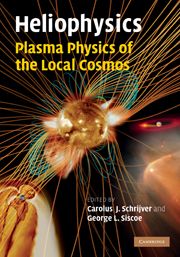Book contents
- Frontmatter
- Contents
- Preface
- 1 Prologue
- 2 Introduction to heliophysics
- 3 Creation and destruction of magnetic field
- 4 Magnetic field topology
- 5 Magnetic reconnection
- 6 Structures of the magnetic field
- 7 Turbulence in space plasmas
- 8 The solar atmosphere
- 9 Stellar winds and magnetic fields
- 10 Fundamentals of planetary magnetospheres
- 11 Solar-wind– magnetosphere coupling: an MHD perspective
- 12 On the ionosphere and chromosphere
- 13 Comparative planetary environments
- Appendix I Authors and editors
- List of illustrations
- List of tables
- References
- Index
10 - Fundamentals of planetary magnetospheres
Published online by Cambridge University Press: 05 August 2013
- Frontmatter
- Contents
- Preface
- 1 Prologue
- 2 Introduction to heliophysics
- 3 Creation and destruction of magnetic field
- 4 Magnetic field topology
- 5 Magnetic reconnection
- 6 Structures of the magnetic field
- 7 Turbulence in space plasmas
- 8 The solar atmosphere
- 9 Stellar winds and magnetic fields
- 10 Fundamentals of planetary magnetospheres
- 11 Solar-wind– magnetosphere coupling: an MHD perspective
- 12 On the ionosphere and chromosphere
- 13 Comparative planetary environments
- Appendix I Authors and editors
- List of illustrations
- List of tables
- References
- Index
Summary
Introduction
The comparative study of the magnetospheres associated with various planets (and with some other objects within the solar system) aims to develop a unified general description of magnetospheric phenomenology and physics that is applicable to a variety of different systems. In this way concepts and theories, often developed in the first instance to fit specific phenomena in a particular magnetosphere, can be tested for correctness and applicability in a more general context.
The subject matter of magnetospheric physics, in general terms, deals with the configuration and dynamics of systems that result from the magnetic field interaction between isolated objects and their environments. Such systems exhibit a variety of fascinating physical phenomena, both visible (e.g. auroral light emissions) and invisible (e.g. charged-particle radiation belts), some of which have significant aspects of practical application (e.g. space weather effects at Earth, radiation dosage problems for spacecraft near Jupiter or Saturn). They also present a special challenge for physical understanding: as regions of transition between an object and its environment, magnetospheres are by their very nature spatially inhomogeneous systems, characterized by the inclusion of very different physical regimes, large ranges of parameter values, and the overwhelmingly important role of gradients.
The aim of this chapter is to present magnetospheric physics, at least in outline, as a self-contained discipline – a branch of physics described in logical sequence, as distinct from a study of individual objects (often presented in historical sequence).
- Type
- Chapter
- Information
- Heliophysics: Plasma Physics of the Local Cosmos , pp. 256 - 294Publisher: Cambridge University PressPrint publication year: 2009
- 5
- Cited by



